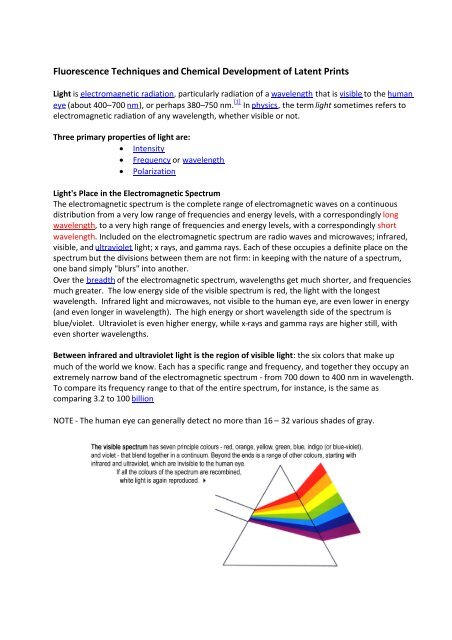General Study Guide - Ontario Police College
General Study Guide - Ontario Police College
General Study Guide - Ontario Police College
Create successful ePaper yourself
Turn your PDF publications into a flip-book with our unique Google optimized e-Paper software.
Fluorescence Techniques and Chemical Development of Latent Prints<br />
Light is electromagnetic radiation, particularly radiation of a wavelength that is visible to the human<br />
eye (about 400–700 nm), or perhaps 380–750 nm. [1] In physics, the term light sometimes refers to<br />
electromagnetic radiation of any wavelength, whether visible or not.<br />
Three primary properties of light are:<br />
Intensity<br />
Frequency or wavelength<br />
Polarization<br />
Light's Place in the Electromagnetic Spectrum<br />
The electromagnetic spectrum is the complete range of electromagnetic waves on a continuous<br />
distribution from a very low range of frequencies and energy levels, with a correspondingly long<br />
wavelength, to a very high range of frequencies and energy levels, with a correspondingly short<br />
wavelength. Included on the electromagnetic spectrum are radio waves and microwaves; infrared,<br />
visible, and ultraviolet light; x rays, and gamma rays. Each of these occupies a definite place on the<br />
spectrum but the divisions between them are not firm: in keeping with the nature of a spectrum,<br />
one band simply "blurs" into another.<br />
Over the breadth of the electromagnetic spectrum, wavelengths get much shorter, and frequencies<br />
much greater. The low energy side of the visible spectrum is red, the light with the longest<br />
wavelength. Infrared light and microwaves, not visible to the human eye, are even lower in energy<br />
(and even longer in wavelength). The high energy or short wavelength side of the spectrum is<br />
blue/violet. Ultraviolet is even higher energy, while x-rays and gamma rays are higher still, with<br />
even shorter wavelengths.<br />
Between infrared and ultraviolet light is the region of visible light: the six colors that make up<br />
much of the world we know. Each has a specific range and frequency, and together they occupy an<br />
extremely narrow band of the electromagnetic spectrum - from 700 down to 400 nm in wavelength.<br />
To compare its frequency range to that of the entire spectrum, for instance, is the same as<br />
comparing 3.2 to 100 billion<br />
NOTE - The human eye can generally detect no more than 16 – 32 various shades of gray.

















